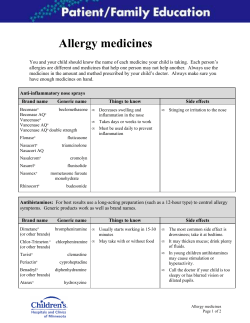
Anticipatory prescribing at the end-of
Anticipatory prescribing at the end of life in South Edinburgh care homes Anne M. Finucane1, Dorothy McArthur2, Hilary Gardner1, Scott A Murray3 (1) Marie Curie Hospice Edinburgh; (2)NHS Lothian Pharmacy Service, Western General Hospital; (3) Primary Palliative Care Research Group, University of Edinburgh; Edinburgh, UK. Background Results •Common symptoms at the end of life include pain, breathlessness, anxiety, respiratory secretions, and nausea. These symptoms can be managed with analgesics, anxiolytics, anti-secretory and anti-emetic medication. •41% of residents who died had no anticipatory prescribing in place. • It can be difficult to obtain medicines quickly for dying residents in care homes unless they are already prescribed. Delays in symptom control are profoundly distressing for patients, family and staff. •Only 15% of residents who died in care homes had anticipatory prescriptions (AP) for all four common end of life symptoms (Figure 3). Figure 1: An anticipatory prescription for a dying resident should include four medicines. Prescription Analgesic: Morphine Anxiolytic: Midazolam Anti-secretory medication: Hyoscine butylbromide Anti-emetic medication: Levomepromazine or haloperidol Figure 2: Percentage of residents who died with anticipatory medicines prescribed for common symptoms at the end of life (N=71). 80 Percentage of deceased residents with AP in place •Anticipatory prescribing is advocated in national end of life care strategies to ensure that key medicines are available to manage symptoms that are likely to occur when a patient is dying (Figure 1). • Anticipatory medicines were most frequently prescribed for analgesia, and least frequently prescribed for nausea and respiratory secretions (Figure 2). 70 60 50 52% 40 38% 30 23% 20 10 0 Analgesia Anxiety Method Data was collected in spring 2013 as part of a larger project to improve palliative care in eight care homes. Each care home provided data on anticipatory prescribing for the last ten care home residents who had died. Data on 77 residents was received, 71 of whom died in the care homes (6 died in hospital). Nausea Respiratory secretions Figure 3: Percentage of residents who died with anticipatory medicines prescribed for all four end of life sympoms. 15% Aim To explore whether patients in eight South Edinburgh care homes had anticipatory medications prescribed prior to death. 21% All four medicines available All four medicines unavailable 85% Conclusions Barriers to anticipatory prescribing in care homes include: • Difficulties diagnosing dying • Lack of knowledge about national anticipatory prescribing guidelines • Cost concerns relating to wastage of medicines • Care home staff concerns relating to storage of medications. Interventions that build the skills and confidence of care home staff to diagnose dying and facilitate anticipatory prescribing are recommended. Acknowledgement: We are grateful to the Robertson Trust for providing funding for this project.
© Copyright 2025












